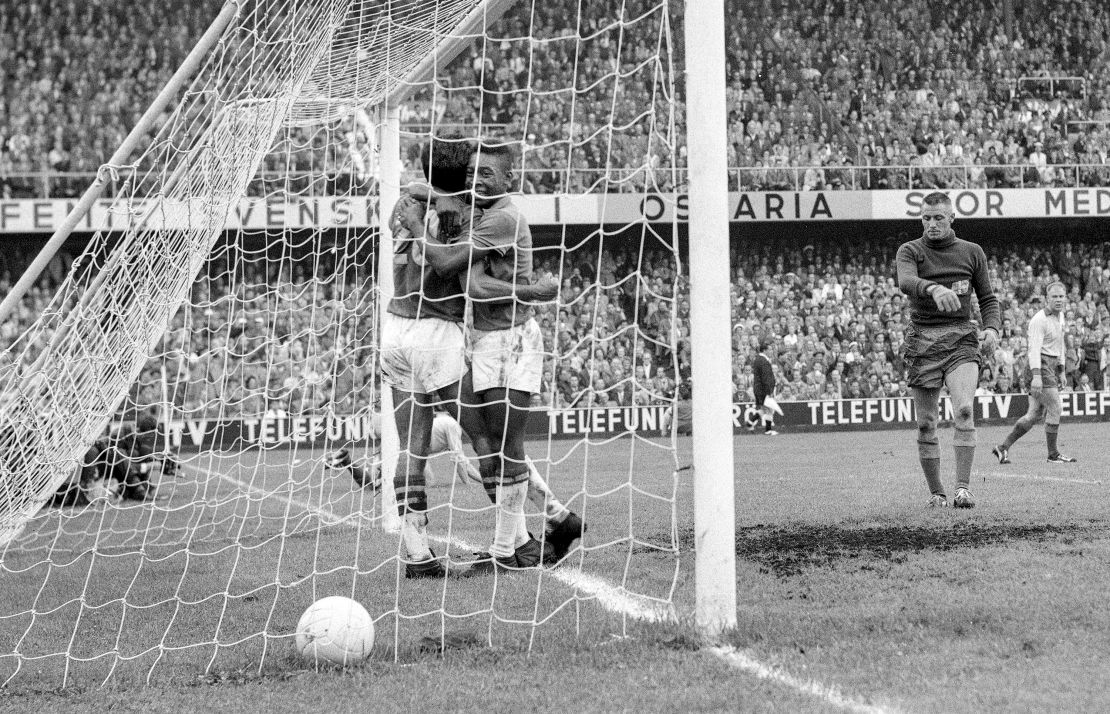
CNN
—
Born into poverty – he used to kick a grapefruit around Brazil’s Minas Gerais state – Pelé finished his career as arguably soccer’s greatest ever player.
He was that rarity; like Muhammad Ali, Pelé was a sports star, who transcended his sport.
The Brazilian brought joy and creativity to a sport often stuck in rigidity and personified o jogo bonito – “the beautiful game.”
“Pele changed everything,” wrote current Brazil international Neymar Jr. after Pelé’s death was announced.
“He turned football into art, into entertainment. He gave a voice to the poor, to Black people and especially. He gave visibility to Brazil.”
From dazzling as a 17-year-old in 1958 on his way to his first World Cup success to claiming the Golden Ball award as player of the 1970 World Cup as he won a third global title, “O Rei” (“The King”) achieved almost everything possible in the famous yellow and blue of Brazil.
And there were goals – lots of them.
Pelé scored 757 goals in 812 official matches for club and country. However, there is disagreement over just how many goals he scored in his career. According to Reuters, Brazil’s football association and Santos say Pelé scored 1,283 goals in 1,367 matches, though FIFA puts the number at 1,281 goals in 1,366 games.
But it wasn’t just the phenomenal number of goals he scored. As Neymar suggests, Pelé was also an artist on the pitch.
“Even if he did not use a brush, or a pen, but simply had a ball at his feet,” says CNN Sport’s Don Riddell.
The world first got a glimpse of Pelé at the 1958 World Cup.
“When we arrived in Sweden, no one knew what Brazil was. They know about Argentina … Uruguay. It was a surprise for us,” Pelé told CNN in 2016.
At the age of 17 years and seven months, Pelé became the youngest person to play in a World Cup, a record the Brazilian held until Northern Ireland’s Norman Whiteside took that landmark in 1982.
Almost 15 years after leaving the world agog at the 1958 World Cup, Pelé hung up his boots for the Seleção, bequeathing his nation the legacy as the most successful in World Cup history and the most feared team in international football.

Pelé’s crowning moment for Brazil came at the 1970 World Cup in Mexico, a tournament further romanticized by being the first World Cup broadcast in color.
Throughout that tournament, Pelé blazed a trail of technicolor splendor, a blur of yellow and gold, beguiling and bewitching opposition teams.
His four goals earned him player of the tournament, capped by an assist to Carlos Alberto’s breathtaking goal in the final against Italy.
“We won the World Cup, and I think in my life in sport (that was the pinnacle), no doubt,” Pelé told CNN.
Italian defender Tarcisio Burgnich summed up Pelé’s superhuman genuis fittingly: “I told myself before the game, he’s made of skin and bones just like everyone else. But I was wrong.”

Even moments when Pelé didn’t score helped cement his legend status – notably England goalkeeper Gordon Banks’ incredible block from the Brazilian’s powerful header in a group game, which is widely considered to be the greatest save of all time.
“The save was one of the best I have ever seen – in real life and in all the thousands of games I have watched since,” wrote Pelé in a 2019 Facebook post in tribute to Banks following the goalkeeper’s death.
“When you are a footballer, you know straight away how well you have hit the ball. I hit that header exactly as I had hoped. Exactly where I wanted it to go. And I was ready to celebrate.
“But then this man, Banks, appeared in my sight, like a kind of blue phantom.”
Despite playing all but three years of his club career with Brazilian side Santos, Pelé’s dynamism, majesty with the ball and lethality in front of goal ensured he became one of football’s first Black global stars.
Pelé admitted to CNN in 2015 that he had plenty of interest from Europe to make the move across the Atlantic, but chose not to out of loyalty and “love” for Santos; yet another reason why he is so beloved in his native country.
“In the past, it was a profession filled with love, now it’s just a profession,” Pelé said.
“There isn’t that love of playing for my club, playing for my country. Clearly, a footballer needs to make a living from the game. It’s different from my time.”
Such was his impact as a soccer player, Pelé also became the symbol of a new country, according to a recent Neflix documentary.
“To cope with that, I think he creates this Pelé character, someone who almost kind of forgoes his own identity to become Brazil essentially,” Ben Nicholas, co-director of the documentary about the Brazilian’s life, told CNN.
As well as shouldering the burden of a country’s aspirations on the world stage, the ascension of the Brazilian military in 1964 that showed interest in football as a tactical and political strategy – in particular, targeting the 1970 World Cup as a “government issue” – presented a problem for the apolitical Pelé, according to the Netflix documentary.
“There’s a really telling line at the end of the film,” the other director of the documentary, David Tryhorn, said, “where you’re expecting Pelé to give us perhaps a ‘Pelé-ism,’ where he would talk about joy and happiness, but he actually talks about ‘relief.’”

The footballing GOAT debate is one which will rage on until the end of time – is it Pelé? Or is it Diego Maradona? Or Lionel Messi or Cristiano Ronaldo?
But, Brazil’s pure love and adoration for Pelé cannot be matched and is one which extends further than just an excellent footballer, but to a totem pole for a nation.





